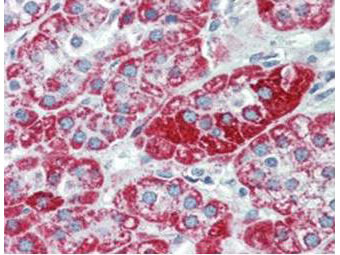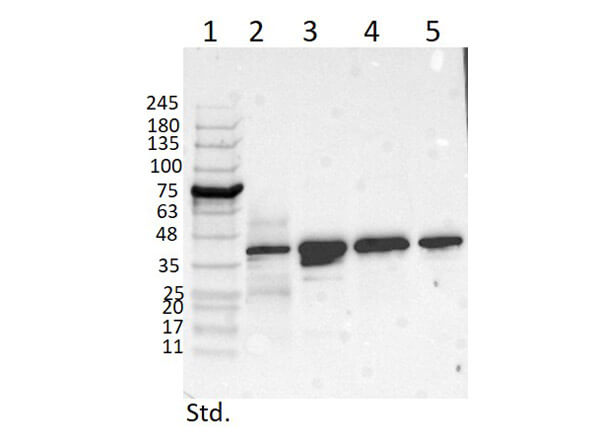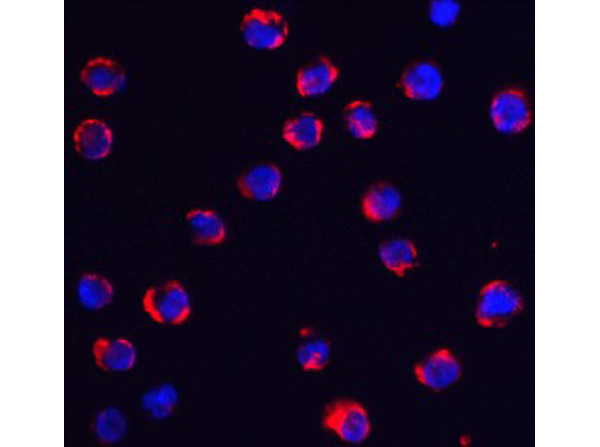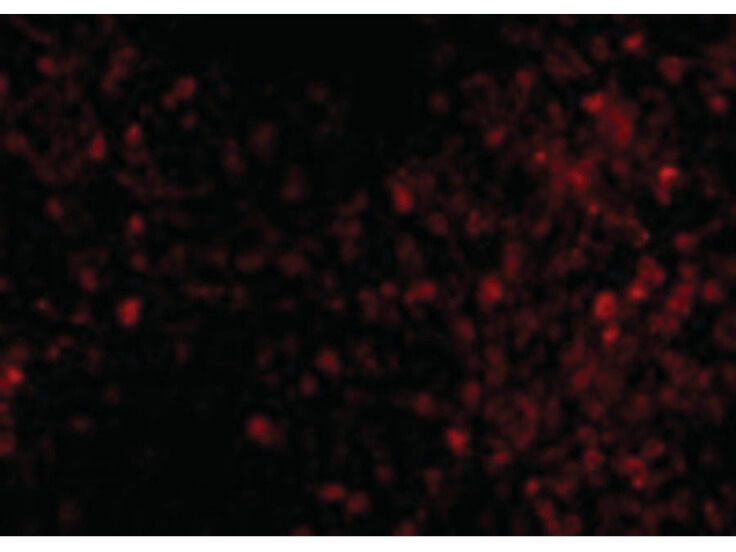Datasheet is currently unavailable. Try again or CONTACT US
TRPC6 Antibody
Mouse Monoclonal 3F2.H10.F2 IgG1 kappa
1 References
200-301-B59S
200-301-B59
25 µL
100 µg
Liquid (sterile filtered)
Liquid (sterile filtered)
WB, ELISA, IHC
Human, Mouse
Mouse
Shipping info:
$50.00 to US & $70.00 to Canada for most products. Final costs are calculated at checkout.
Product Details
Anti-TRPC6 (MOUSE) Monoclonal Antibody - 200-301-B59
mouse anti-TRPC6 Antibody, TRPC 6, TRP6, short transient receptor potential channel 6 and transient receptor potential cation channel subfamily C member 6
Mouse
Monoclonal
IgG1
Target Details
TRPC6 - View All TRPC6 Products
Human, Mouse
Conjugated Peptide
This monoclonal antibody was produced by repeated immunizations with a synthetic peptide corresponding to a region near the carboxy terminus of human TRPC6 protein.
This product was purified from concentrated tissue culture supernate by Protein A chromatography. This antibody is specific for human TRPC6 protein. A BLAST analysis was used to suggest cross-reactivity with TRPC6 from chimpanzee based on 100% homology with the immunizing sequence. Cross-reactivity with TRPC6 from other sources has not been determined.
Application Details
ELISA, IHC, WB
Anti-TRPC6 monoclonal antibody (200-301-B59) clone # 3F2.H10.F2 was developed by Rockland Immunochemicals Inc. against human TRPC6 using conventional hybridoma technology by fusing splenocytes of a host animal immunized with a synthetic peptide corresponding to the cytosolic domain of TRPC6 with myeloma cells. The screening of clones during the subcloning process was based on immunohistochemistry using human tissue microarrays. The pathologist analyzing the staining patterns of clones reported that the antibody shows strong to moderate staining consistent with the localization of human TRPC6 in adrenal cortex, neurons, Purkinje cells, colon epithelium, cardiac myocytes, renal tubules, hepatocytes, skeletal muscle, pancreatic exocrine and islet cells, germinal center lymphocytes, plasma cells, Sertoli cells of the testes as well as staining more faintly other tissues known to be positive for the target protein (e.g., respiratory epithelium). Prostate and placenta were negative for staining. The antibody produced minimal to no background staining and appeared very specific at 2.5 µg/mL. The pattern of reactivity observed for this clone was also similar to other antibodies used for benchmarking purposes. Specific conditions for reactivity should be optimized by the end user, however, we suggest the use of formalin-fixed paraffin-embedded sections for immunohistochemistry. No pre-treatment of sample is required.
While immunohistochemistry was used as the primary screening and release validation immunoassay, clone #3F2.H10.F2 was also screened by western blotting against known positive and negative control lysates. A single band is detected by this antibody in TRPC6 positive cells and tissues; however, the molecular weight of the band (~30 kDa) is not consistent with full length human TRPC6 (181 kDa). The band detected by this antibody may be the cleaved cytosolic domain of TRPC6 as the immunogen used for antibody production corresponds to an amino acid sequence located within this domain. However, no additional data is available to elucidate the molecular composition of this band.
Formulation
0.964 mg/mL by UV absorbance at 280 nm
0.02 M Potassium Phosphate, 0.15 M Sodium Chloride, pH 7.2
0.01% (w/v) Sodium Azide
None
Shipping & Handling
Dry Ice
Store vial at -20° C prior to opening. Aliquot contents and freeze at -20° C or below for extended storage. Avoid cycles of freezing and thawing. Centrifuge product if not completely clear after standing at room temperature. This product is stable for several weeks at 4° C as an undiluted liquid. Dilute only prior to immediate use.
Expiration date is one (1) year from date of receipt.
TRPC6, also known as TRP6, short transient receptor potential channel 6 and transient receptor potential cation channel subfamily C member 6, is thought to form a receptor-activated non-selective calcium permeant cation channel. TRPC6 is probably operated by a phosphatidylinositol second messenger system activated by receptor tyrosine kinases or G-protein coupled receptors. It is activated by diacylglycerol (DAG) in a membrane-delimited fashion, independently of protein kinase C and may not to be activated by intracellular calcium store depletion. Defects in this gene are a cause of focal segmental glomerulosclerosis (FSGS). Expression of this protein has been reported in tissues such as placenta, lung, spleen, ovary, small intestine, and renal podocytes. Immunohistochemistry studies using polyclonal antibodies to this target have shown moderate to strong staining in cell types such as neurons, breast, respiratory, squamous and prostate epithelium, epidermis, placental trophoblasts, dendritic cells, and subsets of immune cells, and faint to moderate staining of adrenal, colon, ganglion cells, hepatocytes, heart, and testis.
Alonso-González et al. (2017). Human Digital Meissner Corpuscles Display Immunoreactivity for the Multifunctional Ion Channels Trpc6 and Trpv4. Anatomical record
Applications
IHC, ICC, Histology
This product is for research use only and is not intended for therapeutic or diagnostic applications. Please contact a technical service representative for more information. All products of animal origin manufactured by Rockland Immunochemicals are derived from starting materials of North American origin. Collection was performed in United States Department of Agriculture (USDA) inspected facilities and all materials have been inspected and certified to be free of disease and suitable for exportation. All properties listed are typical characteristics and are not specifications. All suggestions and data are offered in good faith but without guarantee as conditions and methods of use of our products are beyond our control. All claims must be made within 30 days following the date of delivery. The prospective user must determine the suitability of our materials before adopting them on a commercial scale. Suggested uses of our products are not recommendations to use our products in violation of any patent or as a license under any patent of Rockland Immunochemicals, Inc. If you require a commercial license to use this material and do not have one, then return this material, unopened to: Rockland Inc., P.O. BOX 5199, Limerick, Pennsylvania, USA.






